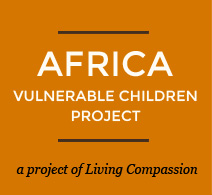My last full day in Zambia. We had planned the day down to the minute and, for the most part, life cooperated.
We started at the bank. No big surprise that we met with yet another snag that prevented us from completing the new bank account. Theresa will have to finish that on her own.
We then went quickly to Jayhind to load the 12 rolls of plastic we were not able to fit in the car the day before. We were rushing to get to Kantolomba in time to be there when the garbage trucks came at 10 hours. As I was walking into the store, I heard a shout from across the street. “Jen!” I turned to see Douglas and his wife. They were in town to shop for the day’s ingredients for their bakery items. It was great to meet his wife, who seemed tickled that I greeted her with “mashabukeni,” a Bemba word meaning “good morning” that I had learned just moments before. She does not speak English, as she dropped out of school in grade 5.

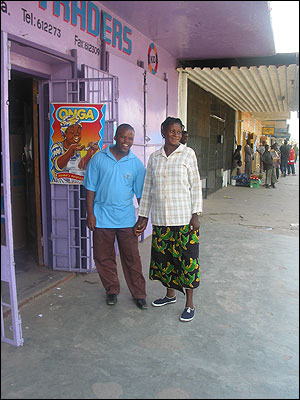
Douglas and his wife.
After loading the plastic into the car, we headed off for the big garbage adventure in Kantolomba. We received a disappointing phone call from Norma at the newspaper saying that the photographer slated to cover the story had lost his father that morning. They would likely not be able to send someone to the site. We decided there would be many other opportunities to have the media join us in Kantolomba and let it go.
It turned out the garbage equipment had been dispatched earlier than expected, and when we arrived we found a huge front-end loader and trash truck already in Kantolomba. We had talked to Patrick on the phone who said he would be late and to go ahead and get started. We led the truck and front-end loader through the narrow, rutted roads to the main trash site. Dozens of children trailed along behind shouting and cheering, many never having seen such equipment before.

Theresa admiring the trash truck
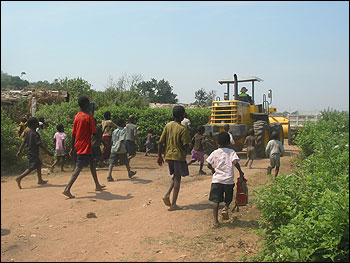
The skill of the front-end loader operator was impressive. I had been concerned that the narrow passages and tight space of the site would prove difficult for this massive equipment. Instead, the driver navigated effortlessly as he ferried enormous loads of garbage from the temporary landfill to the truck. Very quickly the truck was full. I was disappointed thinking it would take weeks to haul all of this away. To my great surprise, the crew was prepared to take the truck back and forth to the city landfill as many times as needed to clear all of the trash the community had collected. By noon, what had been a gigantic mountain of garbage was once again an empty lot. It is thrilling to think that Kantolomba will be the first clean compound in Ndola, perhaps Zambia. There is much work yet to do, several months worth, but the process is underway!
 |
 |
During the garbage loading, Theresa and I stole away for just a moment to collect the clay pots that had been completed. A big packing job lay ahead for me. We once again thanked the potter for her efforts and told her we are committed to finding a market for her beautiful products in the U.S.
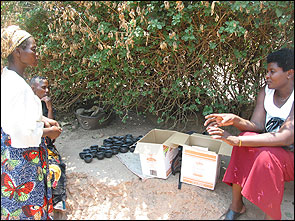
Before we left to come to Zambia this time, Rebecca, our photographer from the July trip, had printed several hundred pictures to give to people. It is one of the best things we have ever done, as people had been so grateful to receive them. For many in Kantolomba, it is the only photograph they have of themselves.
I still had the 100 individual photos of each of the children in the school program, and Theresa felt strongly that I should participate in passing them out. Today was our last chance so we headed into the classroom to distribute them.
When we walked into the schoolhouse, we were touched to find Georgina, one of the teachers, had initiated an ambitious project. A few days earlier I had given the class some blank white paper and crayons. On each piece of paper Georgina had drawn a simple picture and written the name of one of the children. She had given each child his or her paper to color in the drawing. She presented me with the drawings to take home as a representation of each child.

The children coloring their pictures.
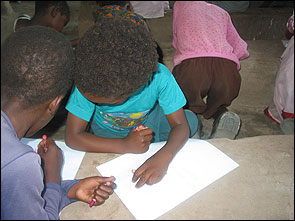
Georgina, Josephine, and Theresa helped me pass out the photographs to the children. It was great fun to see their wide grins as they examined a picture of themselves and showed it off to their buddies. With very few cameras or mirrors in the compound, it is likely many of the children do not have a sense of what they look like. Often when we arrive, one of the great fascinations for the children is looking at their reflections in our car.

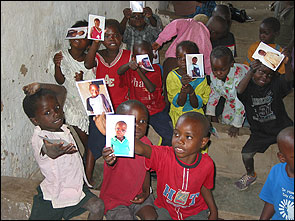
When we got to the photo of a girl named Beatrice, Georgina explained to me that she was absent that day because her mother was being buried. Her father had died the year before. I just stood there; Georgina went on to the next picture. People do not take death lightly here, it is a very big deal, but it is so much a part of everyday life.
When we finished passing out the pictures, the teachers explained to the children that I was saying goodbye but would be back in January (our next planned trip). We had big waves and many handshakes as Theresa and I made our way out the door.
We walked out to find the trash hauling still underway and dozens of children gathered to watch. I caught sight of one girl, about 8 years old, holding her arms in the air, like a surgeon who has just scrubbed and is waiting to be gloved. Every inch of her arms were covered in white, oozing sores. I asked Theresa about it. Scabies, she explained. It is very contagious, and if any child comes to school with it, he or she is sent home to go to the clinic before coming back. I wondered who is looking after this child, if anyone, and has let it get so advanced. Perhaps her caregivers are ill themselves and not able to make the journey on foot to the closest medical care several kilometers away. Or maybe they do not have the funds to pay for the medicine (since the girl is not under 5, she would not qualify for free medicine). It will be a blessing beyond measure when the Living Compassion medical clinic is up and running right here in Kantolomba.
We said goodbye to all our colleagues whom we have grown to know much more in these two short weeks. They remarked that they will miss us, though we all agreed that January is not too far off.
We headed back into town to go to a local mechanic. The Living Compassion vehicle is a typical Zambian car: a second-hand Toyota imported from Japan to South Africa and driven up to Zambia. It has over 133,000 km on it and has not been running well recently. The price of acquiring a car in Zambia is far beyond the actual value when you factor in the cost to get the vehicle shipped and the high import taxes. We need this car to last a lot longer.
It is our good fortune that Gershom used to work for the military as the manager of their fleet of vehicles. He has many mechanic friends. He took us to meet Eddy as a potential candidate. We liked him right off. Eddy took the car out with us—free of charge—to give us his take. His assessment matched exactly with what Cheri had suspected. When he showed us the log book he keeps, one page for each vehicle he cares for, detailing when the oil was changed, transmission serviced, etc., we were sold. He explained to us that our vehicle is a strong one, and that he would get it back into good running order. He said the one real danger with these types of cars is overheating. It could ruin the engine. He said if the temperature gauge ever goes above half, stop. He gave Theresa his cell phone number and told her to call if that ever happened, and he would come meet her wherever she was to see what was going on. Seems we are in good hands.

We proceeded to the Guest House for a quick, late lunch before going to the Living Compassion house to say goodbye to the children. We had a nice few minutes together, remarking that by the next time we are in Zambia, Auntie B will be living with them in the house. Big smiles all around. We are feeling very good about the transition.
Just as we were starting the car to leave, Theresa remembered the chitenge rug. We had all forgotten. The girls ran in the house to retrieve what turned out to be a beautiful work of art! They handed it to me proudly and turned it over to the back to show me that they had cleverly woven the chitenge scraps to form a heart with the word ‘Jen’ in the middle. If we could find a cost-effective way to import these, we are sure these girls could make a good living!

A little family time before departing.
Gershom and I dropped Theresa at home before heading to the airport. I wanted to confirm my flight and hadn’t been able to get through to South African Airways on the phone. The sunset was casting an exquisite pink veil over the sky, and just as we pulled into the airport the heavens opened and dropped huge, warm raindrops for about five minutes. It felt like an African farewell.
I confirmed my flight with a delightful, sharp Zambian woman who manages the Ndola airport. I have to restrain myself whenever I meet someone like her not to offer her a job with Living Compassion on the spot. The truth is, we could probably not afford her—she has one of the handful of well-paying jobs in all of Zambia. I settled for knowing that I would likely have the chance to see her many more times on my way through this little airport.
We had one more stop before heading home. I went to speak with Godfrey, the internet guy, about setting up digital camera lessons for our Zambia team. There are just too many exciting things happening in the projects to miss the photo opportunities. We are leaving our digital camera with Pauline, who will store it in the safe at the Savoy Hotel. Godfrey agreed to have 5 thirty-minute lessons with the team, including teaching them how to email photos to us.
Then, back to the Guest House for a long night of packing for the journey home. I was greeted by Douglas, who had taken great care in typing up (requires an enormous effort for an average Zambian—internet café, two-finger typing, relatively large expense, time away from profit-making activities) his proposal for a bakery business for me to bring back to the U.S. He had also managed to borrow a camera to take several photos of the process he and his family do to make their home-based bakery business run. I received the packet as a great honor and responsibility to do everything I can to assist Douglas to manifest his vision. Link here to read a copy of his proposal and see the photos. We are committed to helping in any way we can. If you or someone you know would like to be involved, please let us know. No investment is a sure thing, but we feel great about this one.
Later, while I was busy rolling the clay pots in the chitenge bags and placemats to safeguard them for the journey, there was a knock on my door. Douglas stood at the door with a beautiful little cake saying, “Would you please deliver this cake for me to the people of the United States of America.” I could not have made a better ending for the day if I were writing a screenplay. So, next time you eat a delicious pound cake, consider it a gift from Douglas.
Before going to bed I called and checked on Theresa. She reported being nearly 100%. She guessed her lunch had not agreed with her and predicted a full recovery by morning.
